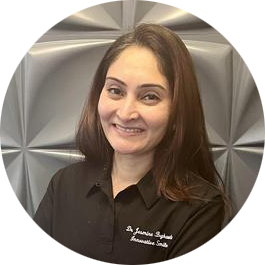Gum recession is a common condition, especially in adults over 40, according to the California Dental Association. It occurs when the gums pull back towards the root of the tooth. In severe cases, receding gums expose the root. Much of the time, this condition is caused by periodontal disease, which is commonly referred to as gum disease. However, the American Dental Association cautions that your gums may also recede as a result of brushing too hard, smoking, trauma to the gums, or even genetics. Contact your Cerritos dentist today if you have further questions about receding gums treatment.
Why you should be concerned
Many people tend to treat receding gums as an aesthetic problem until it is too late. This is mostly because they don’t fully understand what is causing them to recede. Regardless of whether the cause is gum disease or not, the inflammation of the gums will eventually cause them to pull away. Unfortunately, this creates pockets where bacteria can hide and grow. Even if your condition didn’t begin with an infection, gum disease will soon become part of the problem.
As your condition worsens, the infection will eat through tissue and eventually bone. As a result, the root of the tooth will become increasingly exposed, making you sensitive to hot and cold foods. Eventually, you’ll begin to feel that your teeth feel a little loose, as your gums are no longer providing the expected support. At this stage, it is possible that surgery will be required to rectify the situation by clearing the infection and replacing the lost tissue.
Treatments
The sad truth is that your gums cannot simply grow back, regardless of what we would like to think. There are many at-home remedies and essential oils that claim to do just that. However, the most they can do is partially reduce bacterial build-up and give you temporary relief from inflammation. Removing the underlying causes will permanently reduce inflammation if you’re careful to not repeat the initial causes, halting the condition’s progression and creating a more aesthetic look.
For Mild to Moderate Cases
The first step in your treatment will be scaling. This procedure aims to remove all plaque both above and below the gum-line. Dr. Boghawala will typically use a hooked surgical element to scrape the plaque upwards and away from your gums.
Dr. Boghawala will clear all of the plaque-causing irritation. This can be uncomfortable, so she may use a local anesthetic. If the mere idea sounds like too much to handle, then schedule a consultation with us at Jesmine Boghawala DDS to learn about sedation dentistry.
From there you have two options:
- The conventional practice is called planing. After scaling your teeth, which can take several visits, Dr. Boghawala will smooth the gum back out over the tooth, encouraging it to re-attach to the tooth.
- The Pinhole Surgical Technique (PST) is a relatively new procedure that has shown consistent efficacy since its first use and offers a minimally invasive approach to gum restoration. According to a professionally-reviewed Medical News Today article, the procedure involves inserting a minuscule hole into the gum tissue, then inserting a tool to help stretch the remaining gum tissue back over the tooth. The core goal is the same as planing, to encourage reattachment, except PST offers the opportunity to increase tooth coverage.
For Severe Cases
As with any case of receding gums, scaling will be required to ensure that all plaque is removed from the tooth below and above the gum-line. However, in severe cases, the entire root of the tooth is exposed and there is a risk of losing the tooth to the lack of protective support in place.
As a result, Dr. Boghawala will likely suggest gum graft surgery if your case is extremely advanced. During this procedure, a surgeon will remove a small piece of healthy gum tissue, usually from the roof of the mouth, and place it over the damaged area. The new tissue is stitched into place to give it the opportunity to attach properly.
After Care
Once you’ve been treated for receding gums, a strict, daily oral hygiene routine is a must. In addition, if there was another cause, such as ill-fitting dentures or grinding your teeth while you sleep, then speak to Dr. Boghawala about preventing future cases of gum disease.



